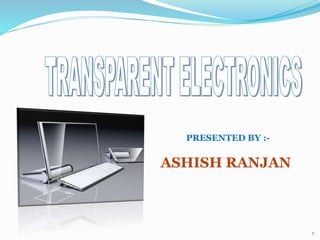
PPT (TRANSPARENT ELECTRONICS)
- 1. PRESENTED BY :- ASHISH RANJAN 1
- 2. INTRODUCTION Transparent electronics (also called as invisible electronics) is an emerging technology. It employs wide band-gap semiconductors for the realization of invisible circuits and opto-electronic devices. The first scientific goal of this technology must be to discover, understand, and implement transparent high-performance electronic materials. The second goal is their implementation and evaluation in transistor and circuit structures. The third goal relates to achieving application- specific properties since transistor performance and materials property requirements vary, depending on the final product device specifications.
- 3. PRE-HISTORY Material Bandgap (eV) Conductivity (Scm-1) Electron Concentration (cm-3) Mobility (cm2V-1s-1) In2O3 3.75 10,000 >1021 35 ZnO2 3.35 8,000 >1021 20 SnO2 3.6 5,000 >1020 15 Table 1: Electrical properties of common TCOs The two technologies which preceded and underlie transparent electronics are Transparent Conductive Oxides (TCOs) and Thin- Film Transistors (TFTs). TCOs constitute an unusual class of materials possessing two contradictory physical properties-high optical transparency and high electrical conductivity. The three most common TCOs are indium oxide In2O3, tin oxide SnO2 and zinc oxide ZnO2.
- 4. The thin-film transistor (TFTs) is another technology underlying transparent electronics, since it is a bridge between passive electrical and active electronic applications. But it does not evolve a fully transparent transistor. Fig 1: Structure of TFTs
- 5. HOW TRANSPARENT ELECTRONIC DEVICES WORK? The challenge for producing "invisible" electronic circuitry and opto-electronic devices is that the transistor materials must be transparent to visible light yet have good carrier mobilities which requires a special class of materials having "contra-indicated properties". Oxide semiconductors are very interesting materials because they combine simultaneously high/low conductivity with high visual transparency. Transparent oxide semiconductor based transistors have recently been proposed using as active channel intrinsic zinc oxide (ZnO).
- 6. The main advantages of using ZnO are:- 1. The fact that it is possible to growth at/near room temperature high quality polycrystalline ZnO, which is a particular advantage for electronic drivers, where the response speed is of major importance. 2. Since ZnO is a wide band gap material (3.4 eV), it is transparent in the visible region of the spectra and therefore, also less light sensitive. The second is amorphous oxides with heavy metal content, such as amorphous InGaZnO4 (a-IGZO) also used in this application. OXIDES PLAY KEY ROLE : Oxides ZnO InGaZnO4 Fig 2:- The major substrate used for this purpose is Glass. Diamond Glass Fig 3:-Graph showing variation of transmittance and wavelength of Substrate.
- 7. Researchers at Oregon State University and Hewlett Packard have reported their first example of an entirely new class of materials which could be used to make transparent transistors that are inexpensive, stable, and environmentally benign. ADVANCEMENTS MADE IN TRANSPARENT ELECTRONICS Significant advances in the emerging science of transparent electronics, creating transparent "p-type" semiconductors that have more than 200 times the conductivity of the best materials available for that purpose a few years ago. This basic research is opening the door to new types of electronic circuits that, when deposited onto glass, are literally invisible. Fig 4: Generation of Transparent Electronics
- 8. Characteristics other than Transparency. Transparent semiconductors, in addition to being transparent, have a number of useful characteristics, including a wide band gap, relatively high carrier mobility, low-temperature manufacturability, and low manufacturing costs thanks to the low-temperature process and inexpensive materials. As a result, R&D into properties other than transparency is also active. Lets consider the properties of materials other than transparency and their applications…
- 9. APPLICATIONS OF TRANSPARENT ELECTRONICS Transparent circuits will have unprecedented applications in flat panel displays and other electronic devices, such as see through display or novel display structures. They have been widely used in a variety of applications like: 1. Antistatic coatings 2. Touch display panels 3. Solar cells, 4. Flat panel displays 5. Heaters 6. Defrosters 7. Optical coatings. and many more….
- 10. FUTURE SCOPE In the field of solar cells, although much progress has been made in developing new materials and devices for high performance transparent solar cells, there is still plenty of opportunity to study and improve device performance and fabrication techniques compared with the nontransparent solar cell devices. It is likely that new scientific discoveries and technological advances will continue to cross fertilize each other for the foreseeable future.
- 11. CONCLUSION Oxides represent a relatively new class of semiconductor materials applied to active devices, such as TFTs, SWNT transistors. The combination of high field effect mobility and low processing temperature for oxide semiconductors makes them attractive for high performance electronics on flexible plastic substrates. Let us hope that we are soon going to see transparent technology being implemented in our lives…!!!
- 12. REFERENCES 1. ‘Transparent Electronics ’, Springer publications, J.F.Wager, D. A. Keszler, R. E. Presley. 2. ‘Transparent electronics: from synthesis to applications’, Wiley publications: Antonio Facchetti, Tobin J. Marks. 3. www.alternative-energy-news.info/transparent-a-solar- energy-breakthrough/ 4. www.nanomarkets.net 5. www.nikkeibp.co.jp
- 13. That’s all about Transparent Electronics…!!! Thank you and queries…!!!
